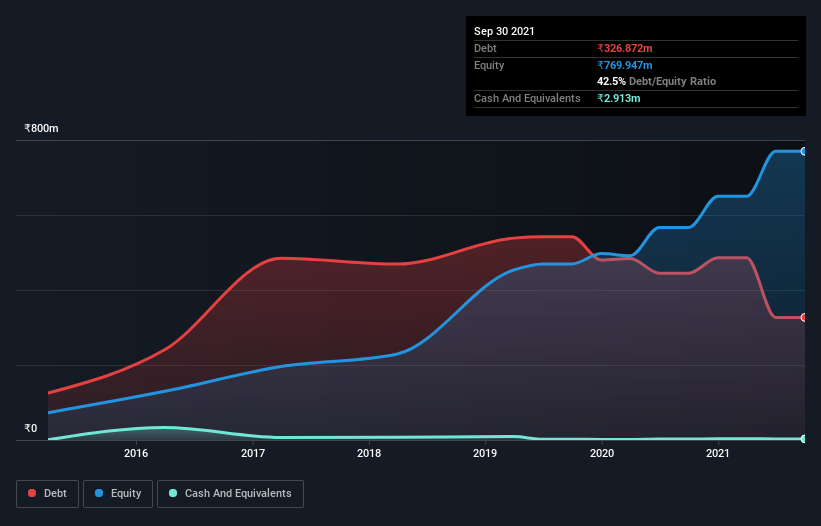Does B&B Triplewall Containers (NSE:BBTCL) Have A Healthy Balance Sheet?
Warren Buffett famously said, 'Volatility is far from synonymous with risk.' When we think about how risky a company is, we always like to look at its use of debt, since debt overload can lead to ruin. We note that B&B Triplewall Containers Limited (NSE:BBTCL) does have debt on its balance sheet. But should shareholders be worried about its use of debt?
When Is Debt A Problem?
Debt assists a business until the business has trouble paying it off, either with new capital or with free cash flow. In the worst case scenario, a company can go bankrupt if it cannot pay its creditors. However, a more frequent (but still costly) occurrence is where a company must issue shares at bargain-basement prices, permanently diluting shareholders, just to shore up its balance sheet. Of course, plenty of companies use debt to fund growth, without any negative consequences. The first step when considering a company's debt levels is to consider its cash and debt together.
Check out our latest analysis for B&B Triplewall Containers
What Is B&B Triplewall Containers's Net Debt?
You can click the graphic below for the historical numbers, but it shows that B&B Triplewall Containers had ₹326.9m of debt in September 2021, down from ₹444.8m, one year before. Net debt is about the same, since the it doesn't have much cash.

How Healthy Is B&B Triplewall Containers' Balance Sheet?
Zooming in on the latest balance sheet data, we can see that B&B Triplewall Containers had liabilities of ₹544.5m due within 12 months and liabilities of ₹207.5m due beyond that. On the other hand, it had cash of ₹2.91m and ₹390.9m worth of receivables due within a year. So its liabilities outweigh the sum of its cash and (near-term) receivables by ₹358.3m.
Given B&B Triplewall Containers has a market capitalization of ₹2.24b, it's hard to believe these liabilities pose much threat. But there are sufficient liabilities that we would certainly recommend shareholders continue to monitor the balance sheet, going forward.
We measure a company's debt load relative to its earnings power by looking at its net debt divided by its earnings before interest, tax, depreciation, and amortization (EBITDA) and by calculating how easily its earnings before interest and tax (EBIT) cover its interest expense (interest cover). The advantage of this approach is that we take into account both the absolute quantum of debt (with net debt to EBITDA) and the actual interest expenses associated with that debt (with its interest cover ratio).
B&B Triplewall Containers has net debt of just 0.78 times EBITDA, indicating that it is certainly not a reckless borrower. And it boasts interest cover of 7.5 times, which is more than adequate. On top of that, B&B Triplewall Containers grew its EBIT by 89% over the last twelve months, and that growth will make it easier to handle its debt. The balance sheet is clearly the area to focus on when you are analysing debt. But you can't view debt in total isolation; since B&B Triplewall Containers will need earnings to service that debt. So when considering debt, it's definitely worth looking at the earnings trend. Click here for an interactive snapshot.
Finally, while the tax-man may adore accounting profits, lenders only accept cold hard cash. So we clearly need to look at whether that EBIT is leading to corresponding free cash flow. In the last three years, B&B Triplewall Containers created free cash flow amounting to 8.3% of its EBIT, an uninspiring performance. For us, cash conversion that low sparks a little paranoia about is ability to extinguish debt.
Our View
Happily, B&B Triplewall Containers's impressive EBIT growth rate implies it has the upper hand on its debt. But the stark truth is that we are concerned by its conversion of EBIT to free cash flow. All these things considered, it appears that B&B Triplewall Containers can comfortably handle its current debt levels. Of course, while this leverage can enhance returns on equity, it does bring more risk, so it's worth keeping an eye on this one. The balance sheet is clearly the area to focus on when you are analysing debt. But ultimately, every company can contain risks that exist outside of the balance sheet. To that end, you should be aware of the 3 warning signs we've spotted with B&B Triplewall Containers .
When all is said and done, sometimes its easier to focus on companies that don't even need debt. Readers can access a list of growth stocks with zero net debt 100% free, right now.
Valuation is complex, but we're here to simplify it.
Discover if B&B Triplewall Containers might be undervalued or overvalued with our detailed analysis, featuring fair value estimates, potential risks, dividends, insider trades, and its financial condition.
Access Free AnalysisThis article by Simply Wall St is general in nature. We provide commentary based on historical data and analyst forecasts only using an unbiased methodology and our articles are not intended to be financial advice. It does not constitute a recommendation to buy or sell any stock, and does not take account of your objectives, or your financial situation. We aim to bring you long-term focused analysis driven by fundamental data. Note that our analysis may not factor in the latest price-sensitive company announcements or qualitative material. Simply Wall St has no position in any stocks mentioned.
Have feedback on this article? Concerned about the content? Get in touch with us directly. Alternatively, email editorial-team (at) simplywallst.com.
About NSEI:BBTCL
B&B Triplewall Containers
Manufactures and sells corrugated boards, boxes and packaging materials.in India.
Low risk and slightly overvalued.
Similar Companies
Market Insights
Community Narratives



